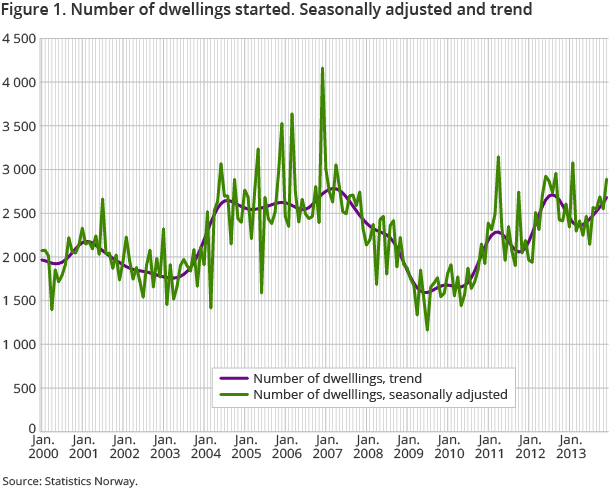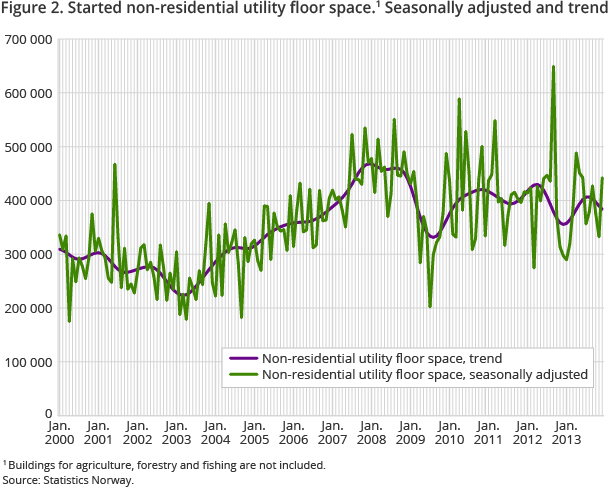Content
Published:
This is an archived release.
Increase in new dwellings
Seasonally-adjusted figures show building start permits increased by 13 per cent from November to December, which follows a 5 per cent decrease the previous month.
| December 2013 | |||||
|---|---|---|---|---|---|
| Seasonally adjusted | Trend | Unadjusted | |||
| Percentage change from the previous month | Percentage change from the previous month | Total | The last 12-months period | Percentage change from the last 12-months period | |
| Dwellings | 13.3 | 2.4 | 2 516 | 30 252 | 0.4 |
| Utility floor space, 1000 m2 | |||||
| Dwellings | 8.3 | 1.3 | 313.0 | 4 130.1 | 2.6 |
| Other buildings | 32.9 | -1.6 | 396.5 | 5 248.7 | -1.8 |


Figures for December 2013 include several major building projects in Oslo.
The number of new dwellings given building starts has increased since April last year, according to the long-term trend. This follows a period of decline and then flattening.
Also increase for non-residential buildings
Seasonally-adjusted figures show that building start permits, measured by utility floor space, for non- residential buildings increased by 33 per cent from November to December 2013. Figures show, however, an 11 per cent decrease from October to November.
The long-term trend shows a slight decrease since August last year in utility floor space for other than non-residential buildings.
Little change from 2012 to 2013
A total of 30 252 new dwellings were given building start permits in the period January–December 2013. This is an increase of 0.4 per cent compared with 2012. Building start permits were given for almost 9.4 million square metres of utility floor space in January–December. This is 1.2 per cent less than in 2012.
Buildings in the industrial sector show a 5.3 per cent decrease compared with 2012. Holiday properties (cottages), private garages and other non-industrial activity saw a corresponding decrease of 0.5 per cent from 2012 to 2013.
Registered building permissionsOpen and readClose
Figures for buildings in the building statistics rely on dates for when permits are registered by the municipality in the data register (Matrikkelen). A building permit does not always mean that construction will be started at once. Especially in low conjunctures it might be that construction projects are not realised, or may be postponed after a building permit has been granted. When the building activity trend turns from a low to a high level, and vice versa, this could affect the interpretation of the statistics.
More details about comparability, quality and other information are available in About the statistics .
Contact
-
Jens Mathiesen
E-mail: jens.mathiesen@ssb.no
tel.: (+47) 40 81 13 98
-
Magnus Espeland
E-mail: magnus.espeland@ssb.no
tel.: (+47) 45 27 40 08
